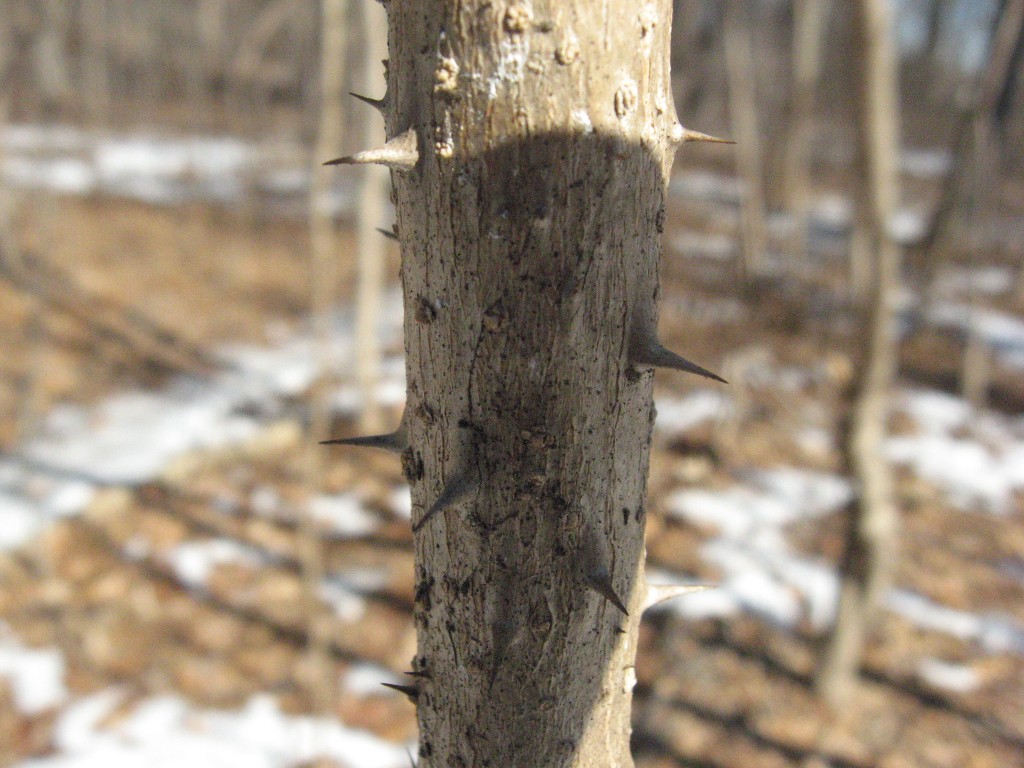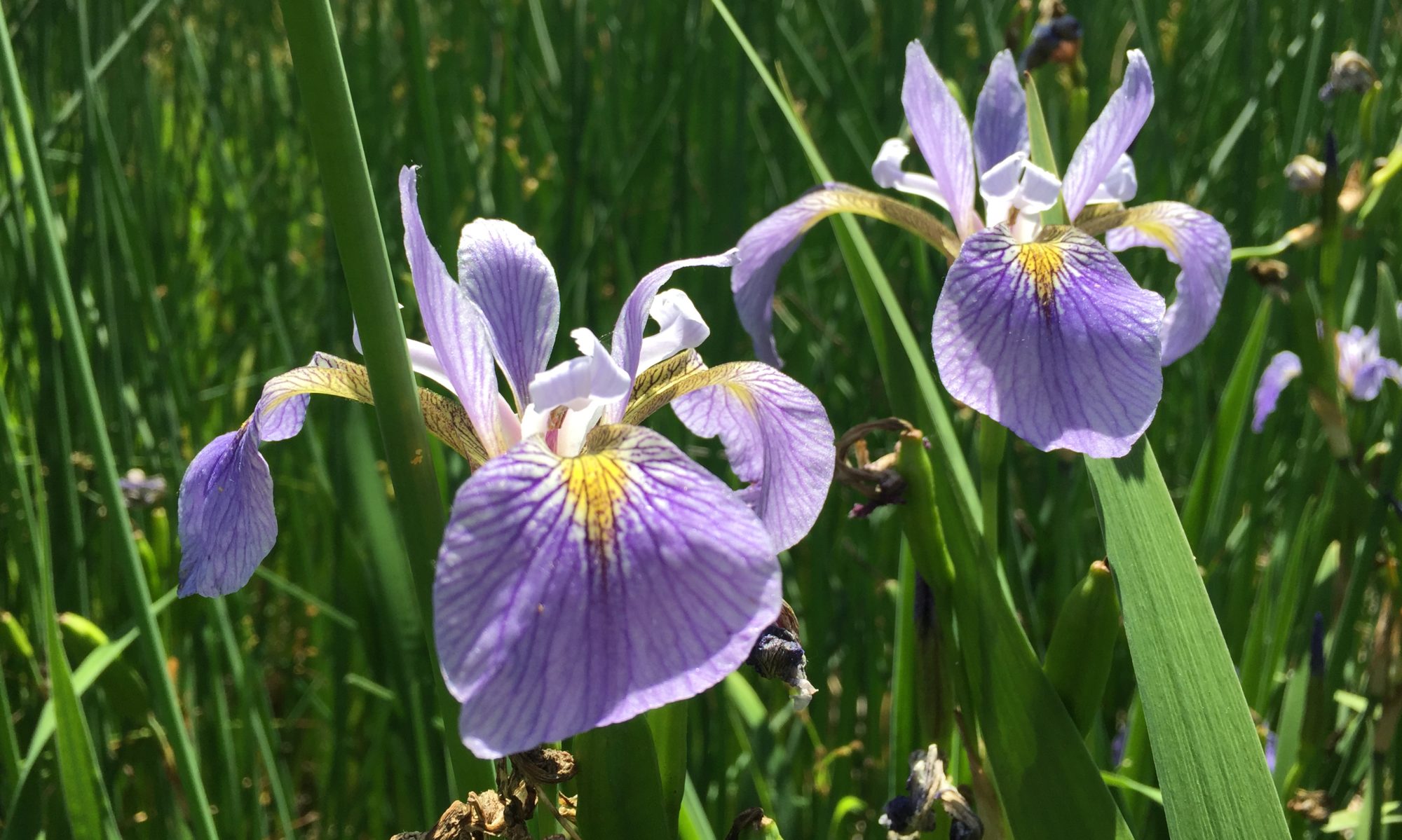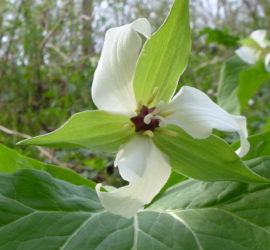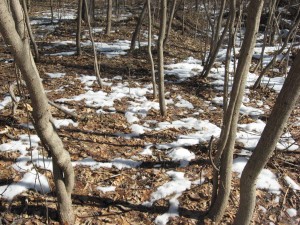ARALIA ELATA. THE JAPANESE ANGELICA TREE HAS EMERGED AS AN INCREASING THREAT. Â NUMEROUS, RAPIDLY GROWING INFESTATIONS ARE BEING DOCUMENTED ACROSS THE PARK. MECHANICAL REMOVAL IS DIFFICULT AND PROBLEMATIC. AREAS IN IMMEDIATE NEED OF RE-FORESTATION ARE INSTEAD EXPERIENCING ECOLOGICAL DEGRADATION BECAUSE OF THIS SPECIES.

An Angel or the Devil?  There has been so much confusion over this species because of its resemblance to the native North American species Aralia spinosa, or the Devil’s Walking Stick also called  Hercules’ Club.  For the longest time we thought it was the native tree growing in Morris Park, and being that it does have very interesting qualities we embraced this plant.  Its beautiful bi and tri-pinnately compound leaves give a sense of refined elegance to the plant world, in that there is a degree of replication and logical order in a single leaf arrangement.  Also the flowers, which bloom in late August throughout September have a commanding presence and pleasing white and subtle pinkish color.  The dark berries it produces are quickly gathered by birds, furthering the plant’s range as the birds deposit the seeds elsewhere.
Of course we looked it up in The Vascular Flora of Pennsylvania, the Annotated Checklist and Atlas by Anne Fowler Rhoades and William McKinley Klein Jr., published 18 years ago in 1993. Â What is called The ‘Devil’s Walking stick’ was listed as native and our county of Philadelphia was included in its native range. This is a clear example of how confusion quickly arises from the usage of common names which is why we use and repeat the Latin names, often to the point that the common name is secondary in our discussion.
Being satisfied with our information we did not investigate the plant further, just left it at that for the time being. Â We did notice how aggressive this tree was.
The similarities to the native Hercules’ Club (Aralia spinosa) had us fooled, along with many others throughout the twentieth century. In the meantime, this species, the Aralia elata, introduced into Fairmount Park in the early Twentieth century  according to the Trees Of Pennsylvania (Rhoades and Block, 2005) was  for  this whole time invading forests, ever increasing in size and expanding its territory to outside of Philadelphia and beyond. Now Aralia elata is considered an emerging invasive by the New Jersey Invasive Species Strike Team , and was featured on their 2010 list of plants to watch. The New Jersey Invasive Species Strike Team  has a sophisticated online map of the  most problematic emerging invasive plants (see interactive map  feature).  It is disturbing to view the prevalence of  Aralia elata on this map. Populations are found throughout the state. It is also rapidly invading forested sections of Long Island in New York State.

The Staff of Fairmount Park (now Parks and Recreation) alerted us to the non-native status of this species. They had by this time already made a ‘first-pass’ effort at controlling a large and disturbing colony in Morris Park, in what is our area of scope.
The learning curve went from there. There is nothing better than being pointed in the right direction. We consulted The Plants of Pennsylvania by Rhoads and Block, the second edition, printed  4 years ago in 2007. Here this ‘Asian Native’ plant was listed as being “naturalized in disturbed woodlands” especially in the “southeast” portion of our state.  Reading The Trees of Pennsylvania, we got a more complete story. We can now distinguish between the native to Pennsylvania (but not Philadelphia County) Hercules Club, Devils Walking Stick, (Aralia spinosa) and the invasive exotic Japanese Angelica Tree, (Aralia elata).
Both plants are in the Ginseng Family, Araliaceae. Â The botanical differences? First of all, we have not ever seen a native to North America but not Philadelphia Aralia spinosa, ‘Hercules Club’. Hopefully that will change, and our horizons will someday be expanded on this front. The natural range of the Aralia spinosa in Pennsylvania is further west in the state. Â If one was found in Philadelphia, it would be considered introduced. Aralia spinosa lacks historical origins in Philadelphia county, and Morris Park. A native species that lacks the local provenance of an area it is introduced to, has the potential to become problematic.
The botanical differences are distinct , but to the discerning eye. Â For now, two differences to start with: the flower on the native Hercules’club (Aralia spinosa) is borne on a distinct stalk, where the inflorescence radiates from a vertical spine. Â The non-native Aralia elata has either an extremely short stalk or none at all. The inflorescence radiates out from one distinct bottom point. Â The leaf is the next to look at: Â In the native Spinosa, there is a border around the leaf, much like Arisaema triphyllum (Jack in the pulpit), whereas the non-native elata has the leaf veins extending to the very edge. (However this is not the most reliable difference in making a definitive distinction between these two closely related species)

Having studied the published data on the Aralia, we then decided to check for ourselves the field data. Â We chose multiple populations in Morris Park to examine as well as ones in The Wyndale Woods in Cobbs Creek Park, multiple populations in the Wissahickon Valley Park and West Park near Memorial Hall. Â The field data examinations were performed during the blossoming of the flowers and the setting of seeds, which occurred between August and October of 2010.
Botanical Descriptions are the most valuable and appreciated in the field, where we are confronted first -hand with the plant in question. We  hang-on to every word of the description and look carefully at the plant, more than we ever have before.  Out of context a botanical description is useful only to a degree, but on site, every aspect is important in positively identifying the plant.
All of our analysis of the botanical features that differentiate Aralia elata from Aralia spinosa were found to be congruous with the conclusions of  the multiple written sources we consulted.
The 12 year old Fairmount Park Master Plan (Volume 2 Cobbs Creek 1999 see ‘park specific’ plans for Cobbs Creek) does not  mention the invasive Aralia elata at all. Why this is could be of two reasons:  That it had  not yet spread into Cobbs Creek and Morris Park (considered part of Cobbs Creek) or, the confusion of its non-native, invasive status was unknown at the time.  Most illustrative of this is the description of the Wyndale Ave Forest, site name ‘Wyndale High Quality Woods’ (v105).  In the description, this area, which is very close to Morris Park, reads:
“This is a high quality area which is considered to be one of the nicest stands of woods in Cobbs Creek Park. Identifying this as a high quality woods and protecting this area against invasion by exotic vegetation and human disturbance is recommended. A survey to identify rare native flora and fauna should be performed to ensure protection of this contiguous parcel of of woods, as it could serve as habitat for various species which are not found in disturbed sites. This area should be maintained by routine exotic removal on the fringes and trash removal by volunteers.”
This beautifully written, concise statement by those who were tasked to assess the whole of the Cobbs Creek/Morris park portion of Philadelphia’s Fairmount Park, has become words cast in bronze, and carved in stone for us at the Sanguine Root. What could better describe our day-to-day life in preserving Morris Park than this eloquent statement written twelve years ago?
The Fairmount Park Master plan, written in the last millenium, over 1/10th of a century ago, is still relevant, and for us, still is a goal to be achieved, especially in what it has to say about Morris Park. In the Sanguine Root Office we have a printed out copy of the pdf in a three ring binder.
However, what is not said in this soon becoming ancient but  still relevant document is the status of the Japanese Angelica Tree (Aralia elata). This species is not even mentioned in the list of Invasive species in Cobbs Creek Park. This was 12 years ago. Was the species not prevalent 12 years ago or was there still confusion about its status and it was overlooked as a problem?  These are our questions, and hopefully they will be answered in time. So, we decided to visit our neighbor, the Wyndale High Quality Woods, V105, and this is what we found: We were so happy to see such a beautiful forest! Oaks, Beeches, ferns, even in late autumn, this place was  the real Pennsylvania through and through. We found an American Chestnut, Castanea dentata. Just about one mile from Morris Park.  However, we  found a significant infestation of Aralia elata, the Japanese Angelica tree. Hundreds of specimens.  This is an alarming situation. First and Foremost, we need to alert the authorities, The Parks and Recreation department of the City Of Philadelphia.  We did this already.  While Morris Park is our Focus and area of Scope, we would be ready at almost any time to also help out with our neighbor, the  Wyndale Ave High Quality Woods, site V 105.
An Angel or the Devil.  The question pricks at our consciousness at every turn, as morality is a human concern and for good reason. However, in the plant and animal world this is irrelevant. Lucky we, that we have the luxury of making distinctions. We are a versatile species, us  Homo sapien sapiens. we can create the problem as a species and we can work to reverse the problem, and care passionately about it on top of that, for whatever that is worth in our estimation.  We, as a species brought the Japanese Angelica tree to our forests.  We thought it was pretty, or it was completely overlooked, introduced  along with some other introduced tree or flower, during the craze of the Centennial Exhibition or in the aftermath.  Regardless, we have to deal with it now.
DEALING WITH ARALIA ELATA
Aralia elata, the Japanese Angelica tree, grows quickly and has a habit of growing in clumps, that increase in size exponentially . The beautiful bi- and tri-pinnately compound leaves are very large, and they shade out the sun preventing other species from growing. On the soil side of things, Aralia elata grows underground runners every which way interfering with any native species at the site. Â The clump becomes a monoculture as other species decline in population and become extirpated.
Removing them by hand can be done, but only in certain situations.  If they can be gently enough teased out of the ground (to disturb the soil as little as possible) but all of the plant must be removed.  Any root fragment left behind will grow into a new tree.  As a temporary step, even just cutting the tree will at least prevent it from going to seed and will slow down its growth of runners.  If there are other young  native tree saplings nearby, hand-pulling can disturb the soil and threaten the native plants.  The runners and roots of Aralia elata often wrap around and penetrate the root systems of other plants. From a hand-control perspective, cutting it down, and then monitoring that one specimen season after season after season, along with any others could work in eradicating it.
Our situation in Morris Park is beyond a few specimens that we could manage by repeated cutting, even though we are on the site every day. Â In one area there is an estimated 1000 specimens, ranging in trunk size from 8 inches thick, to mere whips. This is a monstrous infestation, and is a great challenge. Â The Environmental Stewardship Division of Fairmount Park has, as mentioned earlier, started to address this one problematic patch. Â Also growing at the site are Beech and Oak saplings that are the future of the forest, if the Aralia elata can be eliminated.
On this Friday, February 18, 2011, the staff of the Sanguine Root , in partnership with the Environment and Stewardship Division of Parks and Recreation will be taking steps to eliminate the Aralia elata at this site. Â We will be getting an early start at 10 AM, so as many trees as possible can be eliminated. Â Qualified Fairmount Park Restoration Field Technicians will be working with us, applying herbicide to the stumps as we cut them. We are not sure which one, but possibly triclopyr, which is recommended by the New Jersey Invasive Species Strike Team (see the Control Methods pdf). Â The Sanguine Root Staff is not qualified, certified or authorized to use any herbicides. It is unfortunate we have to have them used at all, but the situation is that difficult and serious.
We are also racing the clock with this project because once the trees begin to exit dormancy they will start producing sap which flows upwards, and would push out any herbicides applied to the cut stumps. Also to be considered is the spring wildflowers such as Bloodroot (Sanguinaria canadensis) and Mayapples (Podophyllum peltatum) will be coming up on this site and we don’t want to accidentally crush them. In light of this, we have fast-tracked our planning and were able to take a day off of work to facilitate this much needed project.





